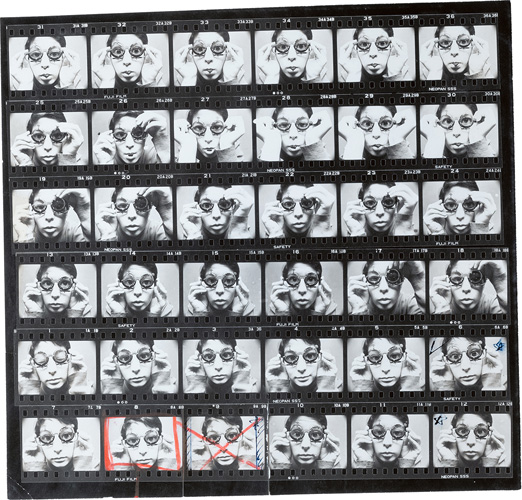About the exhibition
The FUJIFILM SQUARE Photo History Museum is pleased to present an exhibition celebrating 60 years since the release of “A Fallen Angel” by the photographer Yoshihiro Tatsuki, who remains prolifically active at age 87. This exhibition features 25 newly selected gelatin silver prints and 24 contact sheets*1 from the same series, all shown publicly for the first time.
The photographs were taken in 1964, at the height of Japan's rapid economic growth period. At that time, Tatsuki was a staff photographer at the advertising production company Ad Center, where he distinguished himself in apparel advertising and in emerging magazines such as the weeklies Shukan Heibon and Heibon Punch.
Tatsuki's talent was recognized by Shoji Yamagishi, editor of Camera Mainichi magazine. Keenly attuned to the shifting photographic trends of the time, Yamagishi offered the young photographer a deal for a photographic feature in the magazine: no payment, but complete creative freedom. This gave rise to “A Fallen Angel,” starring the then 17-year-old model Noriko Yamazoe, who had an American father. The narrative told through photographs, which ingeniously combined improvisation with structured setups, appeared in the April 1965 issue of Camera Mainichi, filling an extraordinary 56 pages and causing a sensation that endures in the annals of Japanese photographic history.
The photo shoot captured Ms. Yamazoe moving freely through the streets, evoking the feel of an improvised, anything-goes session. For the magazine layout, illustrator Makoto Wada skillfully arranged about 200 prints in the style of a photo book. Commentary was provided by critic Shinichi Kusamori, while poet and playwright Shuji Terayama accompanied the photographs with poems. The Japanese title, “Shitadashi Tenshi,” meaning “Angel with Tongue Sticking Out,” was Terayama's suggestion, and was inspired by the final page's snowy scene, in which the model holds a portrait photo with her tongue protruding.
Contact sheets are prints that condense a sequence of images on a single page in the order they were shot. These sheets are typically used to select shots that make the final cut, and are not usually shown to the public. It is for just this reason that they serve as such a vivid record of collaboration between artist and subject, documenting their ideas, movements, and interactions. Through varied scenes and ever-changing expressions, we invite you to trace the evolving gaze of Yoshihiro Tatsuki as a youthful photographer.
*1 contact sheet is a print made by cutting a roll of black-and-white or color photographic film into 4 to 6 strips, arranging them on a single sheet of photographic paper, and then producing a print at a 1:1 scale. This enables viewing of developed negatives as positive images. It is also known by other names, including “contact print.”
When we dream, no matter how strange the dream is, we are only carried along by it as a raft adrift on waves. Turn the pages of A Fallen Angel too as if you were a raft adrift on waves. Don't think for a minute that the girl with the stars and stripes wrapped around her body straddling a broomstick in the manner of a witch is a critique of civilization. Be a spectator of dreams. Yoshihiro Tatsuki is a driver of dreams and at the same time a spectator as well. Therein lies the newness of this photograph collection. Of course, his photographs differ from the great number of subjective photographs and photographs of images that appeal to the heart of the photographer. Tatsuki tentatively abandons the sort of photograph that is not affected by the elastic force of literature and pictures, in other words the fascination of intuitive feeling (meaning) and composition that tends to fall easily into symbolism. And there is the myth that the essence of the photograph is to record and inform. More aptly, it is like the thoughts a mother holds in her heart. By abandoning intuitive feeling, Tatsuki also draws near to these thoughts (recordability). The photographs are not a group of good friends that tell a photo story. They may seem to be because they record a series of encounters of physical and psychological mechanisms that happen to one girl. This approach avoids the intentional. This concentrated encounter with nonsense is more a documentary than a story. However humorous and sorrowful the girl is, it isn't her fault; it is a statement of accounts, the marks left by burns of 27-year-old Yoshihiro Tatsuki.
— Shinichi Kusamori, commentary on Yoshihiro Tatsuki's “A Fallen Angel,” Camera Mainichi, April 1965
![[Image]Yoshihiro Tatsuki](/assets/img/photo_detail_250106_05_profile.jpg)




![[Image]Yoshihiro Tatsuki Photo Exhibition A Fallen Angel Contact Sheets: An Evolving Gaze](/assets/img/photo_event_250106_05_mv.jpg)




![[image]Hiroh Kikai Photo Exhibition: Persona – Tamasaburo Bando](/assets/img/photo_event_260105_05.jpg)

